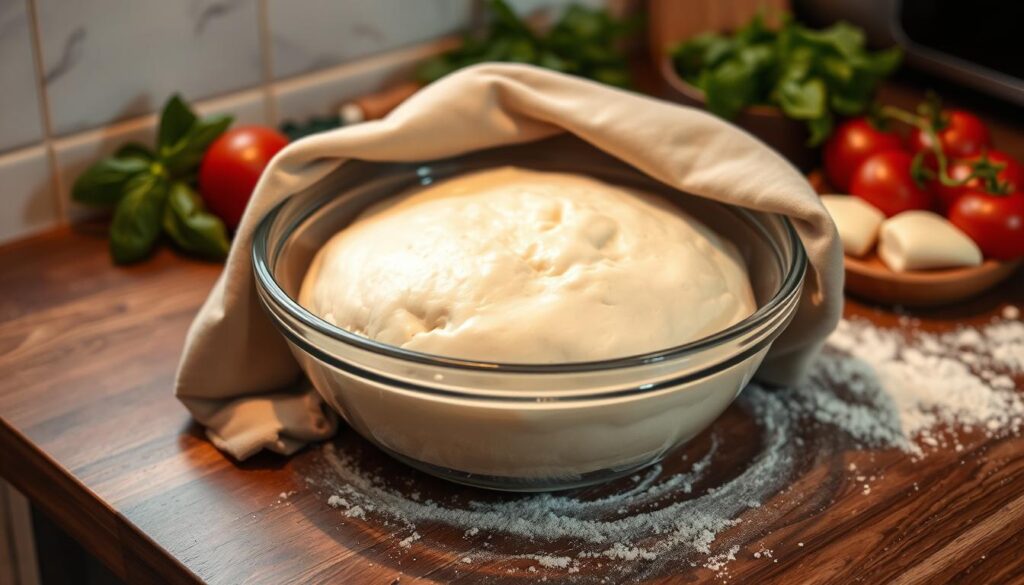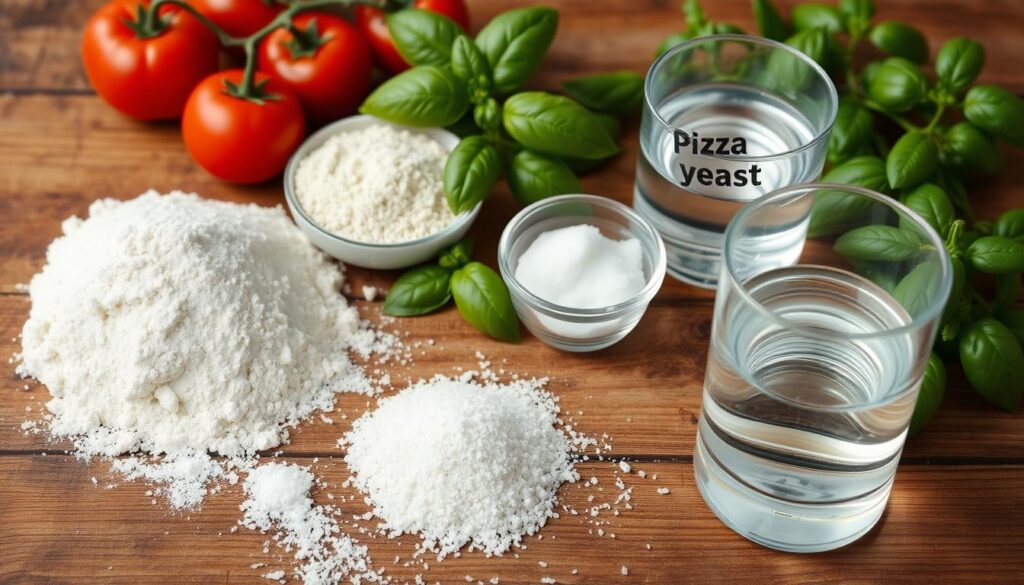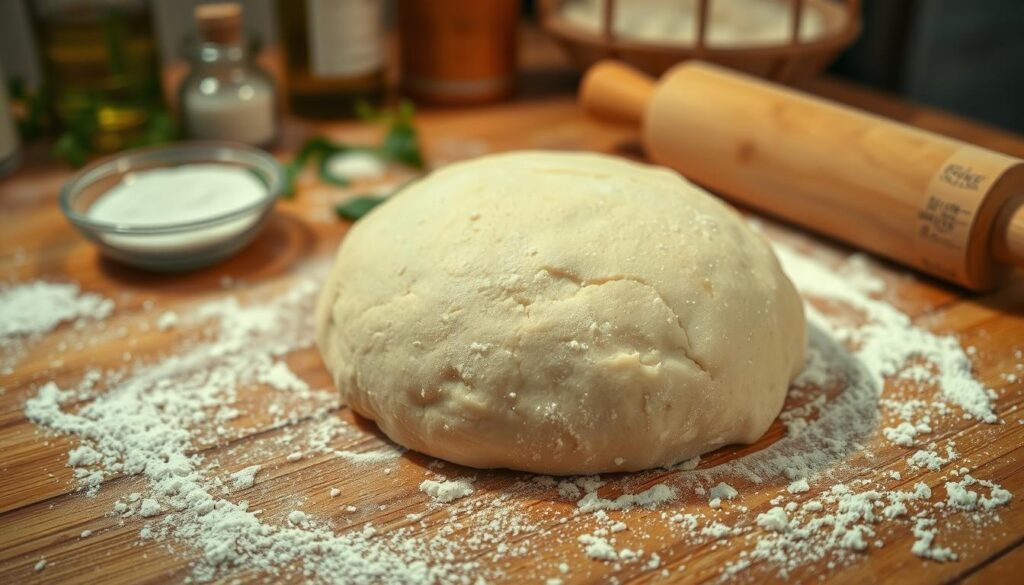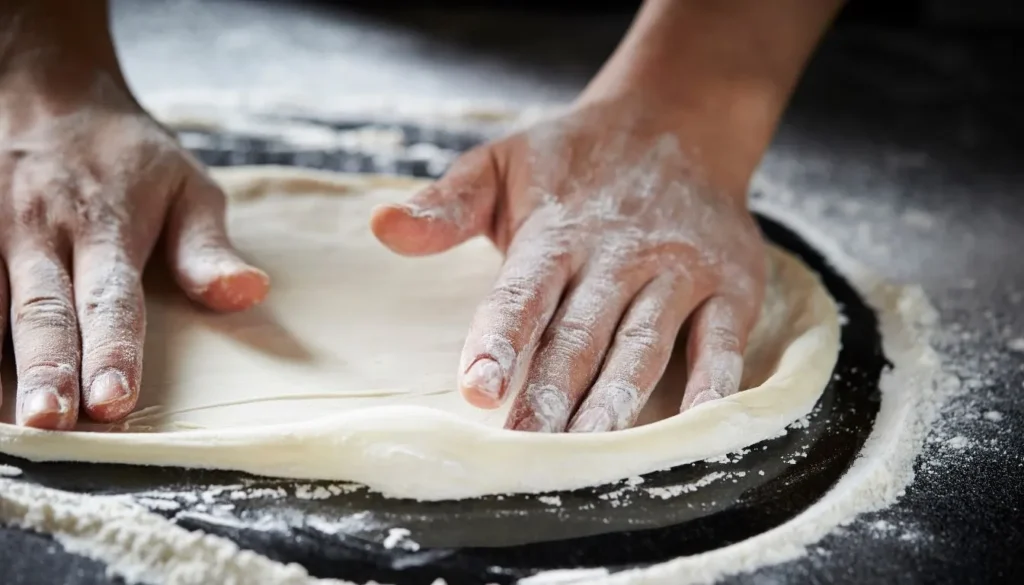Making homemade pizza dough might seem hard, but it’s actually easy with the right stuff. You’ll learn how to make tasty pizzas at home. This guide will show you how to make homemade pizza dough, covering all you need for great results.
Starting your pizza-making journey is exciting. You’ll find out making homemade pizza dough is simpler than you thought. With basic ingredients and a bit of practice, you’ll get a crispy crust. This will make your pizzas even better.
Essential Tools and Equipment for Pizza Dough Making
To make your favorite dough recipe, you need the right tools. A well-stocked kitchen makes creating homemade pizza dough easier. You’ll use these tools to mix, knead, and shape your dough.
For kneading techniques, a clean surface is key. A lightly floured surface prevents sticking and makes kneading smoother. You’ll also need a wooden spoon, measuring cups, and a mixing bowl for any pizza dough recipe.
Must-Have Kitchen Tools
- Mixing bowl
- Measuring cups
- Wooden spoon
- Clean, lightly floured surface for kneading
Optional Equipment for Better Results
While not essential, a stand mixer or pizza peel can help. They make mixing and kneading easier. They also help shape your dough into perfect circles or rectangles.
Surface Preparation Requirements
A clean, lightly floured surface is crucial for kneading. Ensure your surface is free of debris and dust. Lightly flour it to prevent sticking. This makes kneading smoother and helps achieve the perfect dough texture.
| Tool | Description |
|---|---|
| Mixing Bowl | Used to mix and combine ingredients |
| Wooden Spoon | Used to mix and knead dough |
| Clean Surface | Used to knead and shape dough |
Understanding the Science Behind Perfect Homemade Pizza Dough
Starting your pizza-making journey means learning about the science of making dough. This involves proofing and fermentation. These steps are key for the right texture and taste. Yeast is important because it turns sugars into carbon dioxide, making the dough rise.
To help your dough rise well, think about temperature, humidity, and time. The best temperature for proofing is 75°F to 80°F. The humidity should be about 75%. Also, give the dough enough time to rise, which can be 1 to 2 hours, depending on the recipe and the environment.
Here are some key factors to consider during the fermentation process:
- Temperature: 75°F – 80°F
- Humidity: 75%
- Time: 1 – 2 hours
By grasping the science of proofing and fermentation, you can make a tasty homemade pizza dough. It will wow your friends and family. Just keep an eye on temperature, humidity, and time for the best rise and flavor.

Key Ingredients for Your Pizza Base
Making a tasty homemade pizza starts with the right ingredients. The mix of ingredients greatly affects your pizza’s taste and texture. We’ll look at the essential ingredients for a great pizza base, including dough preparation.
First, pick the right flour for your dough. The flour type changes your crust’s texture and taste. You can use all-purpose, bread flour, or a mix. The flour’s protein content affects the dough’s chewiness.
Types of Flour and Their Effects
Here’s how different flours impact your pizza dough:
- All-purpose flour: makes a soft crust
- Bread flour: creates a chewy crust
- Caputo flour: offers a delicate crust
Yeast is also key in pizza dough. It makes the dough rise, giving it a light texture. You can use active dry or instant yeast. Choosing and activating the yeast is important for the dough’s rise and flavor.

Yeast Selection and Activation
Choose high-quality yeast for your dough. Mix it with warm water and sugar to activate it. This step starts the fermentation process.
Don’t forget salt, sugar, and water in your dough. Salt adds flavor, and sugar feeds the yeast. The water’s temperature and quality are also important for the dough’s hydration and texture.
| Ingredient | Effect on Pizza Dough |
|---|---|
| Flour | Affects texture and flavor |
| Yeast | Helps dough rise and ferment |
| Salt | Enhances flavor |
| Sugar | Feeds yeast and promotes fermentation |
| Water | Affects hydration level and texture |
Knowing how each ingredient works in your dough helps make a delicious homemade pizza. Use high-quality ingredients and follow proper techniques for the perfect crust.
Mastering the Basic Homemade Pizza Dough Recipe
To make a delicious homemade pizza, you need to master the basic dough recipe. This involves dough mixing, kneading, and rising the dough to create the perfect crust.
Here are the basic steps to follow:
- Combine flour, yeast, salt, and sugar in a bowl
- Gradually add water and mix the dough until it forms a ball
- Knead the dough for 5-10 minutes until it becomes smooth and elastic
- Let the dough rise in a warm place for 1-2 hours, or until it has doubled in size
With these simple steps, you can create a delicious homemade pizza crust. It will impress your family and friends. Remember to practice dough mixing and kneading to develop your skills and create the perfect crust.

By following these steps and practicing your dough mixing and kneading skills, you will be well on your way to creating delicious homemade pizza. It will become a staple in your household.
| Ingredient | Quantity |
|---|---|
| Flour | 2 cups |
| Yeast | 1 teaspoon |
| Salt | 1 teaspoon |
| Sugar | 1 tablespoon |
| Water | 1 cup |
Kneading Techniques for Perfect Texture
To get the perfect texture for your homemade pizza dough, mastering kneading is key. Kneading spreads yeast evenly, builds gluten, and gets rid of air pockets. You can knead by hand or use a machine, depending on what you prefer and what you have.
Hand kneading needs a gentle but firm touch to avoid overworking. Use a pushing-down motion followed by a folding motion to build gluten. This can take about 10 minutes, depending on your dough’s size and your skill level.

Machine kneading is faster and more efficient. It uses a stand mixer with a dough hook attachment. It kneads the dough in just a few minutes. But, watch the dough closely to avoid overmixing, which can make the crust dense and tough. By mastering these kneading methods, you’ll get a pizza dough with a crispy crust and a soft, airy inside.
Signs of Properly Kneaded Dough
- The dough should be smooth and elastic
- It should have a slightly shiny appearance
- The dough should spring back when pressed with your finger
By following these kneading techniques and tips, you’ll make a delicious homemade pizza dough. It will have a perfect texture that will impress everyone.
Proofing and Fermentation Guide
To make the perfect homemade pizza dough, you must learn about proofing and fermentation. This step is crucial for creating an ideal environment for your dough to rise. It involves controlling temperature, humidity, and time using different techniques. This way, you’ll get a delicious and crispy crust.
For proofing, keep your dough in a warm, draft-free spot, away from sunlight. Use a proofing basket or a lightly oiled bowl, covered with plastic wrap or a damp towel. The best temperature for proofing is between 75°F and 80°F. This ensures your dough rises evenly and avoids over-proofing.
Here are some tips for proofing and fermentation:
- Use a thermometer to monitor the temperature and adjust as needed
- Keep the dough away from drafts and direct sunlight
- Use a humid environment to promote healthy dough rising
- Don’t over-proof the dough, as this can lead to a dense crust
By following these tips and using the right proofing techniques, you’ll create a delicious and crispy homemade pizza crust. Be patient and let the dough rise for the recommended time. This will enhance the fermentation process and result in a better-tasting crust.
With practice and patience, you’ll become a master of proofing and fermentation. Your homemade pizza dough will impress everyone. So, try it out and experiment with different techniques to find what works best for you.
| Proofing Technique | Temperature | Humidity | Time |
|---|---|---|---|
| Room temperature proofing | 75°F – 80°F | 50% – 60% | 1 – 2 hours |
| Warm water proofing | 80°F – 90°F | 60% – 70% | 30 minutes – 1 hour |
Common Pizza Dough Problems and Solutions
As you work on making your own pizza dough, you might run into some common issues. These can affect the dough’s texture, how it rises, and its flavor. It’s important to solve these problems to make a tasty and real pizza.
Texture problems, like a dense or tough crust, can happen if you mix the dough too much or don’t knead it enough. Rising issues might be because of not enough yeast or the wrong temperature and humidity. Also, you might need to adjust the flavor of your crust. This can depend on the flour, yeast, and other ingredients you use.
Texture Issues and Fixes
- Overmixing: Mix the dough just until the ingredients come together, then let it rest.
- Inadequate kneading: Knead the dough for a longer period to develop the gluten.
Rising Problems
To fix rising problems, check the yeast’s expiration date and make sure it’s stored right. Also, make sure the temperature and humidity are good for yeast to work.
Flavor Adjustments
To change the flavor, you can adjust the salt, sugar, or yeast in your recipe. Try different amounts to find the perfect taste for your homemade pizza dough.
By understanding and fixing common pizza dough problems, you can make a delicious homemade pizza. It might take time and practice to get it right. But with patience and flexibility, you can make a pizza that’s as good as your favorite place.
Storage and Make-Ahead Tips
After making your homemade pizza dough, you might wonder how to store it. Proper pizza dough storage is key to keeping it fresh. You can store it in the fridge or freezer, depending on when you’ll use it.
For quick pizza dough storage, put the dough in a lightly oiled bowl. Cover it with plastic wrap and refrigerate. This is best if you’ll use it in a day or two. For longer storage, divide the dough into smaller parts. Place them in airtight containers or freezer bags and freeze.
Here are some make-ahead tips for your dough:
- Make the dough a day in advance and store it in the fridge.
- Freeze the dough for up to 2 months and thaw when needed.
- Use a pizza dough storage container or bag to keep it fresh.
By using these make-ahead tips and proper pizza dough storage, you can have fresh pizza anytime. Always check the dough for spoilage before using. Adjust your storage and handling as needed for the best results.
Conclusion: Your Journey to Pizza-Making Mastery
As you’ve learned, making homemade pizza dough is a journey of discovery and improvement. You now have the knowledge and skills to become a pizza-making master. Remember, homemade pizza expertise goes beyond just following a recipe. It’s about understanding the science, trying new ingredients, and practicing your skills.
Keep exploring, trying new things, and improving your techniques. With time and patience, you’ll make delicious, authentic homemade pizzas. These will impress everyone. Embrace the journey, celebrate your wins, and learn from your mistakes. Your path to pizza-making mastery is just starting, and the future is bright.
FAQ
What are the essential tools and equipment needed for making homemade pizza dough?
You’ll need a mixing bowl, measuring cups, a wooden spoon, and a clean surface for kneading. A stand mixer or pizza peel can also help make the process easier.
How does the science of proofing and fermentation affect the quality of homemade pizza dough?
Proofing and fermentation are key for perfect pizza dough. Yeast, temperature, humidity, and time all affect the dough’s rise and flavor.
What are the key ingredients for making homemade pizza dough, and how do they affect the final result?
Essential ingredients include flour, yeast, salt, sugar, and water. The quality of these ingredients greatly impacts the dough’s texture, flavor, and rise.
What are the best kneading techniques for achieving the perfect homemade pizza dough texture?
Proper kneading, by hand or machine, is crucial for dough texture. Knowing when dough is kneaded right ensures your pizza turns out great.
How can you troubleshoot common pizza dough problems, such as texture issues, rising problems, and flavor adjustments?
Common dough problems include texture and rising issues, and flavor imbalances. Understanding these problems and their solutions helps fix them quickly, ensuring perfect dough every time.
What are the best storage and make-ahead tips for homemade pizza dough?
Proper storage and make-ahead techniques are key for planning and preparing dough in advance. Learn about refrigeration and freezing, and how to make dough ahead of time to simplify pizza-making.


